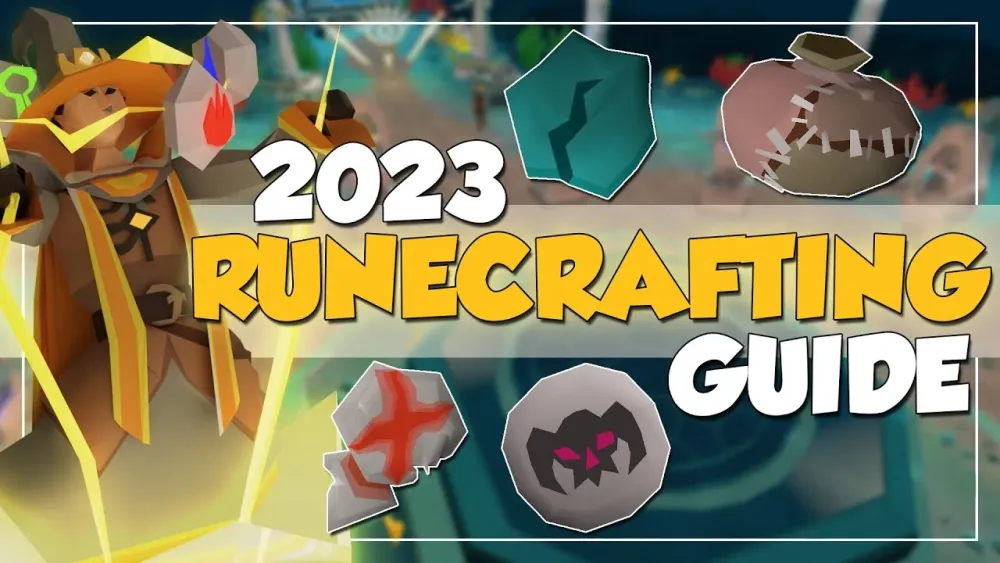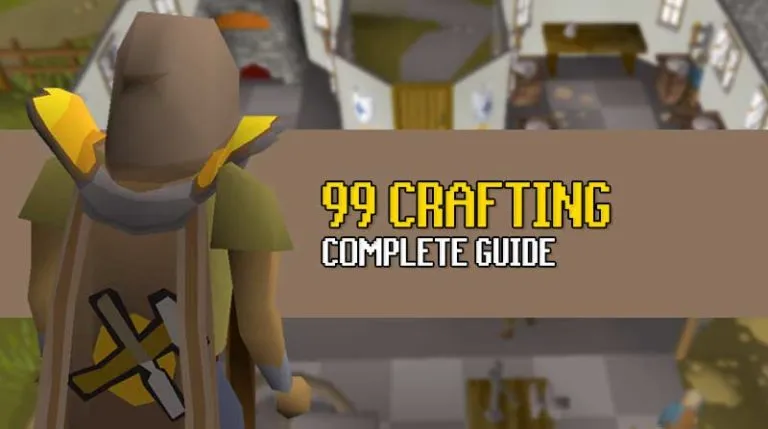Your cart is empty
Ultimate OSRS Crafting Guide for Maximum Profit

Old School RuneScape (OSRS) crafting is a versatile skill that enables players to create a variety of items, from jewelry to armor. Mastering crafting not only enhances gameplay but can also lead to significant profits. This guide delves into the intricacies of OSRS crafting, offering strategies for maximizing your profit margins while efficiently leveling up your skill.
To maximize profits in OSRS crafting, it’s essential to understand various crafting methods and the demand for crafted items within the game. Crafting involves creating multiple items, each with its own profit potential. Key crafted items include jewelry, potions, and armor, each catering to different player needs. The profit margins can vary significantly based on market conditions and item availability.
Jewelry crafting, for instance, is a popular avenue for profit. Players can craft gold rings, amulets, and bracelets. The addition of enchantments can further increase the value of these items. For example, crafting a gold ring and enchanting it into a Ring of Recoil can yield much higher profits than selling the unenchanted version. Utilize the Grand Exchange to monitor prices and determine the most profitable items to craft.
Another profitable crafting method is the creation of pottery. Players can craft items such as bowls and urns, which are in demand for various training methods and skilling activities. Pottery is particularly profitable early in the game, as the materials are relatively cheap and accessible, allowing for a good return on investment.
Leather crafting, which includes making items like leather and dragonhide armor, can also be lucrative. High-level players often seek out these items, especially when training combat skills. The demand for armor, especially during events or updates, can cause prices to spike. Always keep an eye on the market trends to capitalize on these fluctuations.
Additionally, consider the impact of crafting boosts like the Artisan’s Workshop or the use of crafting outfits to enhance your efficiency. These tools can significantly reduce the cost of materials or increase the output of crafted items, leading to higher profits over time. It’s also advisable to engage in crafting quests, as they often provide experience rewards and unlock new crafting options.
In summary, understanding the dynamics of OSRS crafting profits requires awareness of market trends, item demand, and strategic crafting choices. By focusing on high-demand items and utilizing crafting boosts, players can effectively maximize their profits while enjoying the benefits of the crafting skill.
3. Essential Crafting Materials and Tools

To dive into the world of crafting in Old School RuneScape (OSRS), you’ll need a solid handle on the essential materials and tools. Crafting is all about turning raw materials into valuable items, and having the right supplies at hand is crucial for maximizing your profits.
Here’s a breakdown of the key crafting materials:
- Leather: Obtained from cows, sheep, and other animals. It’s used for making armor and various items.
- Gemstones: From mining or purchasing. They are vital for crafting jewelry that can be enchanted for additional benefits.
- Glass: Made from sand and soda ash, glass is essential for creating items like orbs and potions.
- Cloth: Crafted from wool or flax, cloth is necessary for making various clothing items.
- Ore: Mined from rocks; different ores yield different items, from jewelry to armor.
Now, let’s talk tools. Here are some of the must-have tools for crafting:
- Needle: Used for sewing leather and cloth.
- Chisel: Needed for cutting gems and crafting jewelry.
- Hammer: Essential for working with metal ores.
- Spinning Wheel: Used to spin flax into bowstring or wool into cloth.
- Pottery Wheel: Required for making pottery items.
Having these materials and tools handy will set you up for success in your crafting journey!
4. Best Crafting Methods for Profit
When it comes to crafting in OSRS, not all methods are created equal. Some can yield greater profits than others, and understanding which crafting techniques are the most lucrative can make a big difference in your in-game wealth.
Here are some of the best crafting methods to consider:
| Crafting Item | Level Required | Cost | Profit |
|---|---|---|---|
| Necklaces | 16 | Varies by gem | High profit with rare gems |
| Glory Amulets | 40 | 2x Gold Bars + 1x Diamond | Consistent profits |
| Rings of Wealth | 60 | 1x Gold Bar + 1x Ruby | Great for end-game players |
| Pottery | 1 | Clay | Low profit but easy start |
| Leather Armor | 1 | Leather | Steady income |
To maximize your profit, focus on high-demand items like jewelry. Not only do they sell well, but they also provide experience points, allowing you to level up your crafting skill.
In conclusion, combining the right materials, tools, and methods will lead you on the path to crafting success in OSRS. Happy crafting!
Crafting Experience and Leveling Tips
Getting the most out of your crafting experience in Old School RuneScape (OSRS) involves a mix of strategy, efficiency, and understanding the mechanics of the game. Here are some essential tips to help you level up your crafting skill effectively:
- Choose the Right Materials: Always opt for materials that offer the best experience per hour. For example, crafting jewelry (like rings and amulets) tends to provide better XP than making leather items.
- Use Crafting Guild: If you have a crafting level of 40, make sure to utilize the Crafting Guild. It provides a bank, access to better resources, and is less crowded compared to other locations.
- Make Use of XP Lamps: If you have any experience lamps or rewards from quests, don’t hesitate to use them on crafting. They can give you a significant boost in your levels.
- Train with Quests: Completing quests that reward crafting experience can help you level up quickly. Some notable quests include “The Knight’s Sword” and “The Dragon Slayer.”
- Efficient Training Methods: Focus on high-yield methods such as crafting molten glass into items or creating battlestaves, especially if you’re also looking to make a profit.
By incorporating these tips into your crafting journey, you’ll find that leveling up becomes less of a grind and more of an enjoyable experience. Remember, the key to crafting is consistency and smart resource management!
Market Trends and Pricing Strategies
Understanding market trends and pricing strategies in OSRS is crucial for maximizing your crafting profits. Prices can fluctuate based on supply and demand, so staying informed is key. Here’s how you can navigate the marketplace effectively:
| Item | Average Price | Crafting Level Required | Profit Margin |
|---|---|---|---|
| Dragonhide Bodies | 2,000 GP | 40 | 1,000 GP |
| Gold Amulets | 1,500 GP | 40 | 600 GP |
| Glass Blowing | 250 GP | 1 | 150 GP |
Key Pricing Strategies:
- Monitor the Grand Exchange: Regularly check the Grand Exchange prices to spot trends. Use tools like the OSRS Wiki or other price tracking sites.
- Buy Low, Sell High: Purchase crafting materials when prices are low and sell your crafted items when demand is high.
- Diversify Your Crafting: Don’t just stick to one item. Experiment with different crafts to find the most profitable items.
- Be Patient: Sometimes, holding onto your crafted items for a few days can lead to higher profits as the market fluctuates.
By keeping an eye on market trends and employing smart pricing strategies, you can significantly enhance your crafting profits in OSRS. Happy crafting!
7. Advanced Crafting Techniques
Once you’ve mastered the basics of crafting in OSRS, it’s time to level up your skills with some advanced techniques. These methods not only enhance your crafting efficiency but also maximize your profit margins. Here are some advanced crafting techniques you should consider:
- Crafting with Gold Bars: One of the most profitable methods is crafting jewelry. Using gold bars, you can create items like rings, necklaces, and amulets. The demand for these items is consistently high, making them a great source of income.
- Using the Crafting Guild: The Crafting Guild is a fantastic place for advanced crafters. It offers access to a bank and allows you to craft items more quickly. Remember to wear the required crafting cape to enter.
- Creating Battlestaves: Crafting battlestaves can be a cash cow. You’ll need to gather the necessary components, but the profit margins on selling these staves can be significant.
- Glassblowing for Profit: Crafting items from molten glass, such as orbs and lamps, can yield a high return on investment. Focus on creating items that are in demand, like lantern lenses for training construction.
- Utilizing Crafting Contracts: Participating in crafting contracts can offer you exclusive rewards. These contracts guide you to craft specific items, ensuring you focus on what’s in demand.
By implementing these advanced techniques, you’ll not only improve your crafting level but also see an increase in your overall profits. Happy crafting!
8. Common Mistakes to Avoid in Crafting
As you dive deeper into the world of crafting in OSRS, it’s easy to make mistakes that can hinder your progress or reduce your profits. Here are some common pitfalls to watch out for:
- Ignoring Market Trends: Crafting items without checking their market value can lead to losses. Always check the Grand Exchange for current prices before crafting.
- Overlooking Training Methods: Many players focus solely on crafting high-level items for profit, neglecting efficient training methods. Consider crafting lower-level items for faster experience gain.
- Not Using the Right Tools: Make sure you have the right tools, such as a chisel or needle. Crafting without these can slow you down significantly.
- Failing to Plan Inventory: Running out of inventory space can waste time. Plan your crafting sessions and ensure you have enough materials before you start.
- Not Taking Advantage of Bonuses: Various bonuses exist, such as the Crafting Guild‘s experience boosts. Use these to your advantage to level up quickly.
Avoiding these common mistakes will not only enhance your crafting experience but also ensure you’re maximizing your profits. Keep these tips in mind as you craft your way to success!
Ultimate OSRS Crafting Guide for Maximum Profit
Crafting in Old School RuneScape (OSRS) is a vital skill that allows players to create various items, from jewelry to potions, and can be a significant source of profit. This guide will provide you with strategies and techniques to maximize your crafting profits effectively.
Understanding Crafting Materials
To craft items, you’ll need raw materials. Here are the primary materials used in crafting:
- Leather: Obtained from killing cows or using a tanner.
- Gemstones: Can be mined or purchased from shops.
- Glass: Made from sand at a furnace.
- Ore: Mined and smelted into bars before crafting.
High-Value Crafting Items
Focusing on high-value items can significantly increase your profit margins. Some of the most profitable items to craft include:
| Item | Level Required | Profit per Item |
|---|---|---|
| Dragonhide Armor | 63 | 1,500 – 3,000 GP |
| Gold Jewelry | 40 | 500 – 1,200 GP |
| Glass Items | 81 | 300 – 700 GP |
Efficient Training Methods
To maximize profits, consider these efficient training methods:
- Buying Materials in Bulk: Purchase resources in bulk to reduce costs.
- Using Crafting Packs: Engage in crafting packs to save time and maximize output.
- Utilizing the Grand Exchange: Leverage the Grand Exchange for buying and selling crafted items at the best prices.
Conclusion
Maximizing your crafting profits in OSRS requires a strategic approach to materials, item selection, and efficient training methods. By focusing on high-value items and utilizing resources effectively, you can significantly increase your income from crafting.
